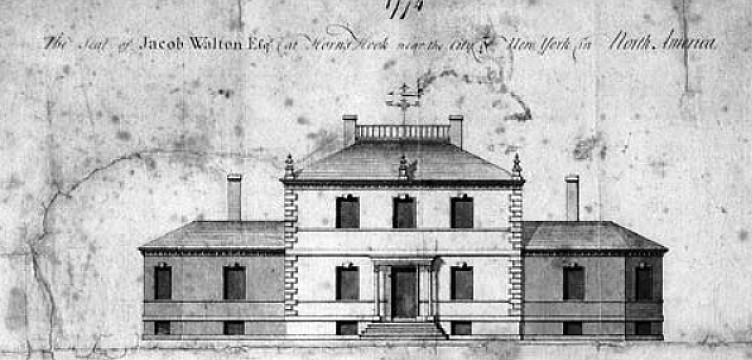Belview
Horn's Hook, Manhattan, New York
Completed in 1774, for Jacob Walton (1730-1782) and his wife Mary Cruger (1743-1781), daughter of the 41st Mayor of New York. Also spelt 'Belleview' or 'Bellevue,' their elegant riverside mansion was blown to smithereens by British cannon shot during the Revolution. In 1799, the Gracie Mansion - official residence of the Mayors of New York City - was built in its place on part of the foundations....

This house is best associated with...
Jacob Walton Jr. was the grandson of Captain William Walton (1675-1747) who established the family's "notorious" fortune when he was given a virtual monopoly over all the Spanish trade in the West India Islands and at the Port of St. Augustine in Florida - having relieved their government of a substantial debt. His father and uncle continued the business and were considered to be among the most prominent of New York City's merchants, which coupled with their marriages into the politically prominent Beekman family made Jacob Walton one of New York's wealthiest and most influential citizens.
Horn's Hook
Horn's Hook
In 1646, Sybout Claasen received a grant of 106-acres from the Dutch West India Company on the Upper East Side of Manhattan. Today part of Carl Schurz Park, Claasen named the land "Hoorn's Hoek" after his native village of Hoorn in Holland which hooked out into the Bay of Zuiderzee in much the same way as his grant hooked out into the East River. Over time, the spelling was corrupted by the English to "Horn's Hook" and it became part of the Waldron family's farm.
In 1763, Jacob Walton's maternal first cousin, James Beekman (1732-1807), built the historic Mount Pleasant mansion overlooking Turtle Bay on the East River, inducing Jacob to build something similar nearby. Seven years later, Jacob paid £438 for just under 7-acres at Horn's Hook from the estate of the late William Waldron. Later that year, he purchased four adjoining acres from Adolph Waldron (1729-1818) which now gave him just short of 11-acres on which to build his country seat.
The Walton House
Walton's country home was finished in 1774, complete with a secret tunnel that ran through to the river shore. His brother-in-law, Lt.-Colonel John Harris Cruger (1737-1807), valued it at just over £1,700. Typically Georgian in its symmetrical design, it was reached by stone steps that led up to the flat-roofed portico supported by Corinthian columns. Belview was built with dressed limestone and stood two-and-a-half stories high with single story wings either side of the central block. The ground floor was centered by a large entrance hall flanked either side by the drawing room and dining room, with three smaller rooms behind. On the hipped roof between the two chimneys was the "widows walk" that offered a magnificent 360-degree view over the river and surrounding countryside that gave rise to its name, corrupted from the French for "beautiful view".
Revolution
Revolution
In 1776, on the outbreak of Revolution, the Loyalist Waltons fled to Long Island. A contemporary account reported that on receiving the news that she must depart, Mrs Walton, "burst into tears, for she was fixed to her heart's desire".
Belview's strategic position overlooking the East River was not lost to Jacob, and nor was it either to General Charles Lee (1732-1782). General Lee immediately saw that its location was invaluable for the protection of Manhattan from the British Navy. In July, Colonels Paul Dudley Sargent (1745–1828) and Israel Hutchinson (1727-1811) were sent to secure Horn's Hook. They commandeered the house, erected a 9-gun battery on the lawn, and the grounds became barracks for 250-men. By early September, after a 10-day exchange of cannon-fire with a British fort just across the river in Queen's County, the American defences - and Belview - were reduced to a heap of rubble.
Becoming the Gracie Mansion
Becoming the Gracie Mansion
Jacob Walton's will was proved in 1791, having left instructions for his executors to, "sell and dispose of all and every part of my real estate," the proceeds of which would go to his three surviving children: Anne, wife of Commodore Richard Valentine Morris, U.S.N.; Judge Henry Walton of "Pine Grove"; and, Elizabeth, wife of Captain Hon. Clotworthy Upton (1768-1822) R.N. In 1798, the shipping magnate "with the soul of a prince" - Archibald Gracie (1755-1829) - paid the Walton heirs $5,625 for the Belview estate and some of the foundations of the old house were re-used to build the Gracie Mansion which since 1942 has served as the official residence of the Mayors of New York City.
You May Also Like...
Categories
Styles
Share
Image Courtesy of the New York Public Library; Guide to Sources for Women's History (1993), Public Record Office for Northern Ireland; Memoirs of the Life of Henry Van Schaack (1892), by H. Cruger Van Schaack; dutchdoorgenealogy.com; Fortress America: The Forts That Defended America, 1600 to the Present (2007), by J.E. and H.W. Kaufmann; Sargent and Hutchinson arrive at Horn’s Hook, New York (This day in History, July 28, 1776), from History.com; New York City's Gracie Mansion: a History of the Mayor's House (1984), by Mary Black, Joan R. Olshansky & the Gracie Mansion Conservancy; In Drawing, Guide to Past of Gracie Mansion Site (2007), from The New York Times
Connections
Be the first to connect to this house. Connect to record your link to this house. or just to show you love it! Connect to Belview →






